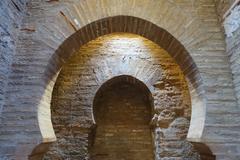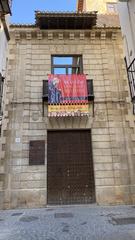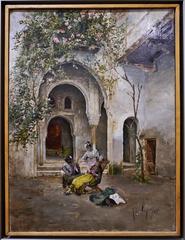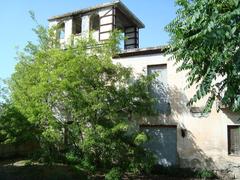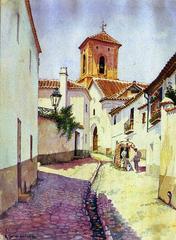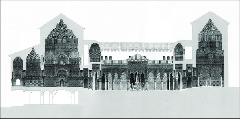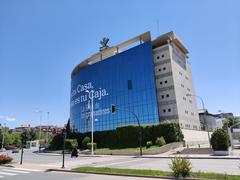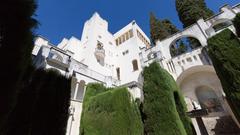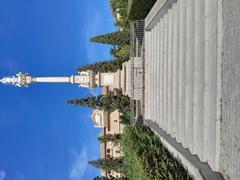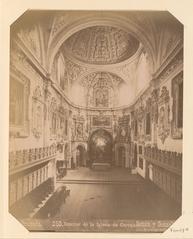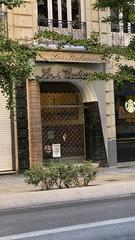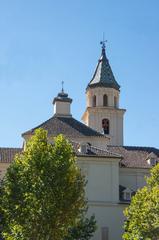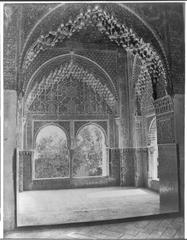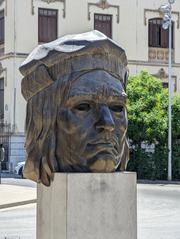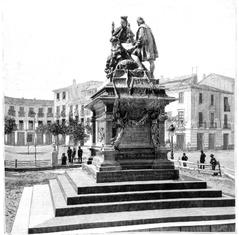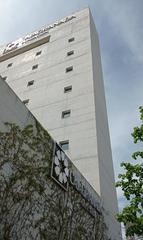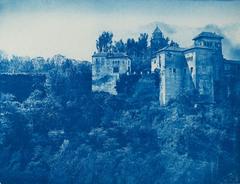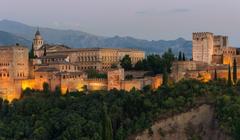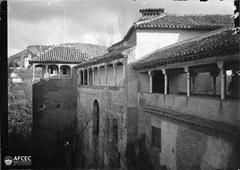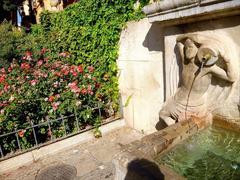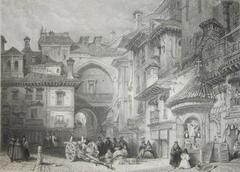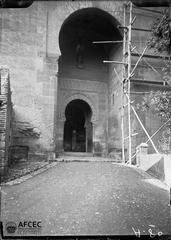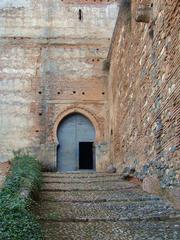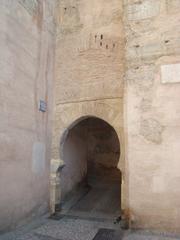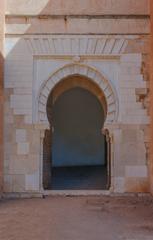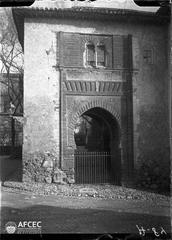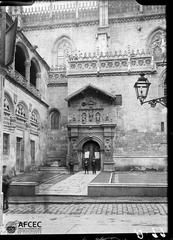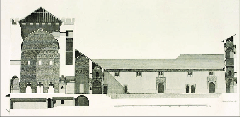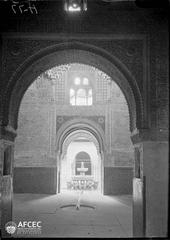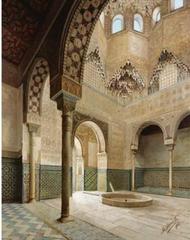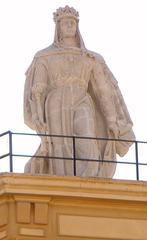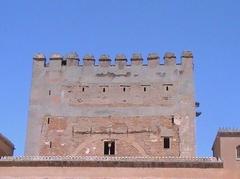Lavadero de la Puerta del Sol, Granada: Visiting Hours, Tickets, and Travel Guide
Date: 14/06/2025
Introduction
Nestled in Granada’s historic Realejo district, the Lavadero de la Puerta del Sol is a rare survivor of 19th-century public washhouses and an emblematic site for the city’s social, architectural, and communal history. Built in 1862 during a wave of public health reforms, it once served as a central gathering point for working-class women and local residents, fostering community bonds and reflecting a pivotal era in Granada’s urban development.
Preserved through meticulous restoration, the lavadero is now the only remaining example of its kind in Granada. Its elegant structure—featuring six Sierra Elvira marble columns, a timber roof with traditional Arab tiles, and a tranquil plaza with panoramic views—invites both history enthusiasts and casual travelers to explore an often-overlooked chapter of Granada’s past. Located near the iconic Alhambra and Albaicín neighborhoods, this site is a meaningful addition to any cultural itinerary.
This detailed guide covers the lavadero’s origins, architectural highlights, social significance, practical visitor information, restoration efforts, and travel tips. For further reference, see Estefanía Granada Tours, Granada Digital, and the official Albaicín Granada PDF.
Table of Contents
- Introduction
- Historical Background
- Architectural Features
- Visitor Information
- Unique Features and Visitor Experience
- Frequently Asked Questions (FAQ)
- Summary and Travel Recommendations
- References
Historical Background
Origins and Urban Context
The Lavadero de la Puerta del Sol occupies a strategic spot in Realejo, at the site of the former city gate “Puerta del Sol,” which dates to the Zirid period (11th century). This gate, demolished in 1868, once marked the transition between Granada’s Jewish quarter and the rest of the city. The area’s historical and geographical context makes the lavadero a living testament to Granada’s layered urban evolution (Estefanía Granada Tours; Albaicín Granada PDF).
Construction and Public Health
Constructed in 1862 under architect José Contreras, the lavadero was part of Granada’s initiative to improve hygiene and mitigate epidemics in an era before widespread indoor plumbing. Utilizing repurposed materials from the demolished Ermita de Santa Escolástica and local cemeteries, the washhouse offered a practical solution for communal laundry while advancing public health. The structure was supplied by the Acequia Real, the same irrigation channel that serves the Alhambra (GranadaDigital; La Razón).
Social and Cultural Significance
Beyond its utilitarian function, the lavadero was a vital social hub. It provided a rare public space where women could gather, share news, support each other, and build lasting friendships—creating an informal but important network within the neighborhood. Its role in fostering female sociability and community resilience is a critical element of Granada’s social history (GranadaDigital; ExclusiveGranada).
Architectural Features
Structure and Materials
The lavadero’s structure features six robust Sierra Elvira marble columns in Doric or Tuscan style, supporting a timber-beamed roof finished with traditional curved Arab tiles. The open-sided portico shelters stone basins (pilas) and is paved with Granadan pebble mosaic (empedrado), reflecting the practical yet elegant design of public utility architecture in 19th-century Andalusia (Estefanía Granada Tours).
Roof and Ornamentation
The roof’s Arab-style tiles harmonize with the region’s vernacular architecture, while the pebble mosaic flooring enhances the site’s historic ambiance. The structure’s open design assures natural ventilation and light, making it both functional and aesthetically pleasing.
Restoration and Preservation
A significant restoration was completed in 2022 under the “Plan Alhambra,” investing €175,000 to stabilize, conserve, and revitalize the lavadero (Granada Hoy; Granada Digital). The project prioritized traditional techniques and original materials, enhancing accessibility with new ramps and pathways. Archaeological studies have uncovered deeper historical layers, including possible Jewish-era origins (DeGranada.net).
Visitor Information
Visiting Hours
- Open Daily: 9:00 AM to 7:00 PM
- Check local tourism sites for seasonal variations.
Tickets and Admission
- Admission: Free for all visitors.
Accessibility
- Wheelchair Access: Ramps and pathways have been added, but the surrounding cobblestone streets may present minor challenges.
- Note: The pebble mosaic floor may be uneven in places.
Getting There and Travel Tips
- Location: Calle Puerta del Sol, Realejo, 18009 Granada, Spain
- Public Transport: Accessible by bus or on foot from the city center.
- Parking: Limited; best to use public transport or walk.
- Recommended Visit Times: Early morning or late afternoon for tranquility and optimal lighting.
- Footwear: Wear sturdy shoes due to cobblestone streets.
Guided Tours
- Availability: Included in many Realejo and Granada historical walking tours.
- Languages: Multilingual options available.
- Booking: Advisable to book in advance, especially during peak seasons.
Nearby Attractions
- Alhambra Palace: World-renowned Moorish citadel.
- Realejo Jewish Quarter: Historic labyrinthine streets.
- Carmen de los Mártires Gardens: Romantic park with city views.
- Mirador de San Nicolás: Iconic viewpoint over the Alhambra.
Unique Features and Visitor Experience
The lavadero is prized for its authentic architectural details and the panoramic cityscape visible from the plaza. Occasional cultural events and guided tours highlight its ongoing role as a “space of encounter” and community pride. Informational signs and QR codes provide historical context for self-guided visitors (Granada Official App).
Frequently Asked Questions (FAQ)
Q: What are the opening hours of the Lavadero de la Puerta del Sol?
A: Daily from 9:00 AM to 7:00 PM.
Q: Is there an entrance fee?
A: No, admission is free.
Q: Is the lavadero accessible for people with disabilities?
A: Yes, ramps and accessible pathways are available, though cobblestones may pose some difficulty.
Q: Are guided tours available?
A: Yes, many local tours include the lavadero; advanced booking is recommended.
Q: Can I take photographs?
A: Absolutely—photography is encouraged.
Q: Are there visitor facilities on site?
A: No on-site amenities; restrooms and cafes are found nearby.
Summary and Travel Recommendations
The Lavadero de la Puerta del Sol is a hidden yet essential destination for anyone interested in Granada’s social history, architecture, and urban evolution. Its preservation and free access reflect a commitment to sharing Granada’s heritage with all. Combine your visit with other Realejo and Alhambra sights for a deeper understanding of the city’s past and present.
Travel Tips:
- Visit in the morning or late afternoon for the best experience.
- Wear comfortable shoes and bring water in summer.
- Explore nearby neighborhoods on foot to fully appreciate Granada’s character.
- Respect the site’s heritage and the privacy of local residents.
For more information, consult Granada Turismo, Granada Digital, and Estefanía Granada Tours.
References
- Estefanía Granada Tours
- Albaicín Granada PDF
- GranadaDigital
- Granada Hoy
- Granada Tourism
- La Razón
- ExclusiveGranada
- DeGranada.net
- Granada Official App
For further updates, download the Audiala app for guided tours, detailed audio histories, and exclusive local insights. Your journey into Granada’s living history begins with a visit to the Lavadero de la Puerta del Sol.

